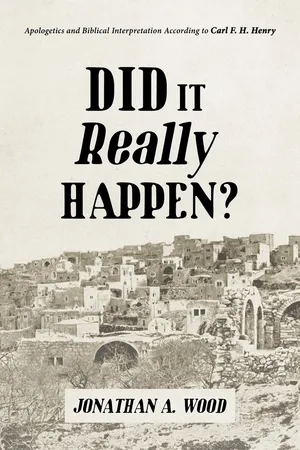![]()
1
Revelation, History, and the Biblical Text
The Evangelical scholars who gathered at the International Council on Biblical Inerrancy for Summit II (ICBI Summit II) came together under the idea that the necessity of inerrancy had been established in the first summit. The first summit produced what has become the foundational document for an evangelical description of inerrancy—The Chicago Statement on Biblical Inerrancy. With the gains concerning the doctrine of revelation, the second council sought to complete the task of the first by carrying through the doctrine of revelation to its impact on hermeneutics as noted through the comment of James Packer, “[b]iblical authority is an empty notion unless we know how to determine what the Bible means.” With this comment, the “hermeneutical problem” for evangelical theology was summarized and the trajectory was set for the ICBI Summit II. The notion that the Bible bears authority because it is communication from an authoritative God carries the implicit consequence that it is then authoritative for those to whom it communicates. Yet, as Packer acknowledges, the authority of Scripture as a function in an interpreter’s life is dependent upon the apprehension of God’s communication through the process of hermeneutics.
The relationship among revelation, history, and the biblical text is a significant factor for the proper apprehension of biblical meaning. This triad is relevant in constructing hermeneutical approaches and thus bears impact on the breadth of theological method. Craig Bartholomew notes the existence of four broad turns in the history of modern hermeneutics. These turns are the historical, literary, postmodern, and theological turns. The narrative provided by Bartholomew’s account of these hermeneutical phases leads one from the initiation of hermeneutics that are historically focused to the questions that evangelicals must now face concerning the relation of history to text. As has been documented by chroniclers of interpretive history, beginning in the eighteenth century, a shift took place toward a preoccupation with historical method. The resulting dominance of the historical-critical method in biblical and theological studies had a serious effect as noted by Edgar Krentz who writes:
The net effect was that historical justifiability must be present for taking the biblical text seriously. This development still holds influence, and its mark is evident on the most common hermeneutic of modern evangelicalism, the historical-grammatical method. While many historical-grammatical interpreters may take exception to being identified with the positivist, imminentist trappings of the historical-critical method, evangelical interpretation has maintained a basic historical orientation. The historical shape of evangelical hermeneutics is typified in Gordon Fee’s statement:
In the early twentieth century, following the historical turn, literary criticism developed out of concern that historically focused reading neglected the literary shape of the text itself. Alter and Kermode note, “[historical] criticism was of great cultural and doctrinal importance; but, as we have said, it diverted attention from biblical narrative, poetry, and prophecy as literature, treating them instead as more or less distorted historical records.” The literary turn is marked by an emphasis on the literary analysis of the Bible that does not always have an accompanying concern with historical issues.
Bartholomew points to a development out of literary emphasis into the so-called postmodern turn in the 1980s. The hallmark feature of the postmodern turn is that it served as a challenge to both the historical and literary mindset, by asserting notions of pluralism and the indeterminacy of texts. Bartholomew’s assertion is that “[postmodernity] questions the very foundations of [literary and historical approaches] and alerts us to the inevitability of a plurality of views in biblical interpretation.” Subsequent to the challenge presented by the postmodern turn, the door opened for what Bartholomew identifies as a theological turn. This turn is identified by two marks. First, Scripture is to be read according to its plain sense with a limited role for historical criticism. Second, hermeneutical emphasis is placed on reading under the influence of theology for the church and Christian doctrine.
This cursory summary of approaches to text and history serves to indicate the longstanding tensions between historical interests and theological interests when interpreting Scripture. As Bartholomew argues, as a “theological turn” appears to be afoot, the importance of doctrinal presuppositions concerning Scripture is, in turn, influencing how one reads the Bible. These developments in biblical hermeneutics relate specifically to the issues of revelation, history, and biblical hermeneutics in contemporary evangelicalism. Within the concern of this book on Carl F. H. Henry as a significant theologian of the doctrine of revelation, my hope is that one will find beneficial resources in his writings on these issues.
As Henry’s theology is articulated in the context of those with whom he was conversing, the particular approaches that merit analysis as significant influences on contemporary approaches to revelation, history, and the biblical text are that of Wolfhart Pannenberg and Hans Frei. The summary of biblical interpretation provided above finds a parallel in corresponding theological approaches to the doctrine of revelation with the historical turn represented by the revelation-as-history approach of Wolfhart Pannenberg and the literary turn manifested in the post-liberal approach typified by Hans Frei. As a chief representative of the neo-evangelical movement, the writings of Carl F. H. Henry provide fertile ground for considering these issues from the perspective of the doctrine of revelation.
The Path Ahead
The purpose of this book is to argue that, in contrast to the revelation-as-history and post-liberal approaches to revelation, Henry’s doctrine of revelation generates a text-oriented, yet apologetically engaged, scheme of the relationship between revelation, history, and biblical text.
The connection between one’s doctrine of revelation and h...
